For those of us that love irises, their blooms seem to come and go much too quickly in the average garden. Most irises bloom for a week or two and then fade into the background of the garden for the rest of the season.
This would be the end of the story for the iris if there were only one species of iris to grow. Lucky for us, there are actually several different species and cultivars of iris that bloom at different times throughout the season. Using a mix of different species and cultivars, you can have iris blooming virtually all season long in your garden.
The Misunderstood Iris
Homeowners and landscapers that are not experienced gardeners usually don’t realize the wide variety of irises that are available to them. Most of us can only identify the common bearded iris (iris germanica) with its broad sword-like leaves and its traditional floppy purple blooms. In this post, we’ll introduce you to a handful of other iris species and let you know how to plant them so that you can enjoy them from April until September. All of them are easily available from most well stocked nurseries (or over the internet), and all of them are relatively easy to grow. So, let’s get to know some of them…
Early Blooming Irises
Iris reticulata (Iris reticulata) is the earliest blooming of the irises we’ll discuss here. It is a bulb and therefore must be planted in the fall.
Iris reticulata is a low growing colorful iris that blooms brightly in late March in the Northeast. Its flowers are borne on short stems only about 6 inches high or less and the foliage is very thin and grass like. The blooms usually last into mid-April and then the plant virtually disappears. Unlike most bulbs, it doesn’t go through an ugly phase after blooming. The flowers come in several different colors, but it is most easily found in shades of purple. Since the flower is so small, you will want to plant several (think groups of 50-100 bulbs) to make a statement. Plant this iris in a sunny spot where it will be easily visible. They only need to be planted a few inches deep, so they’re easier than most bulbs. The only drawback to Iris reticulata is that it sometimes peters out after a season or two, so you may have to add additional bulbs to your planting in subsequent years.
Don’t bother looking for this iris in the nursery. Since it is a bulb , it is easiest to buy via mail order or over the internet during the spring or the summer. Buy it in large quantities. Each bulb will only produce one small bloom.
Dwarf Bearded Iris (Iris pumila). This iris looks like an exact miniature of the more common, tall bearded iris (Iris germanica). The flowers are big and showy, and come in all colors of the rainbow.
The foliage is wide and sword-like, and even better looking than its taller cousin. The entire plant is roughly 10-12 inches tall and very compact. Blooms appear in early May and usually last for two weeks. Iris pumila likes well drained soil in a sunny location. Most larger nurseries will carry Iris pumila in containers, but it may be harder to find than other irises. The major drawback of this dwarf beauty is that it experiences a very ugly phase after blooming. Cut flower stalks to the ground, and foliage to about three inches high, after blooming is done or whenever the plant starts to look unsightly. This will help keep a tidy look, and foliage will regrow within a few weeks.
Crested Iris (Iris cristata) This iris is so small, it is usually considered a ground cover. The flowers, however, are showy and plentiful, so it makes an impression even if it only gets four-six inches tall. Unlike most garden irises, this one likes the shade and will spread vigorously, creating a mat of lovely, wide, grassy foliage and beautiful blooms.
The crested iris blooms mid to late May , so it might be in bloom at the same time as Iris pumila depending on where you are located. Don’t let this stop you from planting it. Since it loves shady spots, it can occupy a part of your garden that Iris pumila (and most other irises) won’t tolerate. Bloom color ranges from white through the blues and purples. The foliage also stays great-looking even after the bloom is finished, so there is virtually no maintenance required. The only drawback to the crested iris is the short bloom time (only about a week), but its graceful foliage keeps this plant looking great all season long.
Mid-Season Irises
Tall Bearded Iris (Iris germanica) This is the most common iris in the gardens of the northeast. Its large, showy flowers are familiar to most of us. This type of iris has been cultivated extensively, so there are literally hundreds of varieties available. Tall bearded irises have wide leaves that can appear almost blue-green. They bloom just after Iris pumila in mid to late May and can last two-three weeks.
Tall bearded iris is easy to grow, as long as it is planted in well drained soil and gets full sun. This plant will not tolerate wet feet. Depending on the variety, heights of flower stalks usually vary between two and three feet. The flowers bloom above the foliage, so the plant is somewhat shorter when not in bloom. Flowers are available in all colors of the rainbow and newer varieties will even rebloom in late summer or fall. There are two major drawbacks of the tall bearded iris. One is that the flower stalks sometimes need staking. This varies widely depending on conditions and the variety. The other drawback is that, like its cousin, Iris pumila, it will get very unsightly looking after blooming. Cut back foliage to about six inches after bloom.
Siberian Iris (Iris sibirica) The Siberian iris is a truly graceful plant. It is easier to grow than bearded irises and it maintains lovely foliage throughout the season. It has a tall, slender habit with long green grass-like leaves. Flowers appear slightly later than bearded iris, but the two varieties will overlap for most of their bloom.
Blooms are available in many colors, but the most common varieties are variations of purple or white. Foliage is typically between two and four feet tall with flowers blooming slightly above the foliage. Siberian iris needs more moisture than the bearded varieties, but it is very versatile. It can take both full sun and part shade. It really has no significant drawbacks. Its bloom period is a little shorter than the bearded irises and the flowers are less showy, but the overall effect is very graceful and elegant. Most importantly, the foliage looks great even after blooming is done.
Japanese Iris (Iris ensata) Japanese iris is by far the most elegant of all the irises.
The habit is very similar to the Siberian iris, but the flowers are larger and much more showy. Japanese irises bloom after Siberian irises are past, from late June through mid July. The flowers can be absolutely breathtaking. The flower heads are almost flat and very large, on tall delicate stems. Japanese irises can be a little finicky and need a lot of moisture to thrive, especially up until the time they bloom. It may be for this reason that they are so underutilized in northeast gardens. Japanese irises prefer a moist location in full sun and can even live with their roots submerged in water. If you do not have a moist area in your garden, create a depression in the garden and use plenty of peat during planting. This is their only drawback, otherwise the plant is very low maintenance and the foliage stays looking great all season long.
Late-Season Irises
Reblooming Bearded Irises. Various tall bearded iris cultivars are now available that rebloom in the late season garden. These repeat bloomers have different types of reblooming patterns and may behave differently in different climates.
However, there is one cultivar that is both a reliable rebloomer and easy to find at your local nursery. “Immortality” is a tall bearded iris with white flowers that blooms along with other tall bearded irises, then reliably reblooms in late season (usually August or September). The late season bloom will not produce as many flowers, but it is still a welcome sight in August or September. “Immortality” looks and behaves just like any other tall bearded iris, so follow the same planting guidelines.
Planting Your Iris Garden
Now you know the right irises to buy, so you can get started planting. These irises can be planted anytime you buy them with the exception of iris reticulata, which can only be planted in the fall (anytime before the ground freezes). Just a few things to remember…. The bearded irises need lots of sun, so place them accordingly. The Japanese iris needs lots of water, so water it regularly or plant it in a depression that can collect water naturally. The crested iris likes shade, so give it a nice shady spot close to the edge of your garden where its small size won’t be an issue.
Once again, here is the final line-up for iris blooms all season long:
Iris Reticulata (Iris reticulata – any variety), Dwarf Bearded Iris (Iris pumila – any variety), Crested Iris (Iris cristata – any variety), Tall Bearded Iris (Iris germanica – any variety), Siberian Iris (Iris sibirica – any variety), Japanese Iris (Iris ensata – any variety), Reblooming Iris (Iris x germanica cultivar “Immortality” suggested).
This bloom calendar should help you plan your garden:
Enjoy your beautiful iris blooms and don’t forget to buy your Iris reticulata bulbs in the spring or summer so you can plant them in the fall!


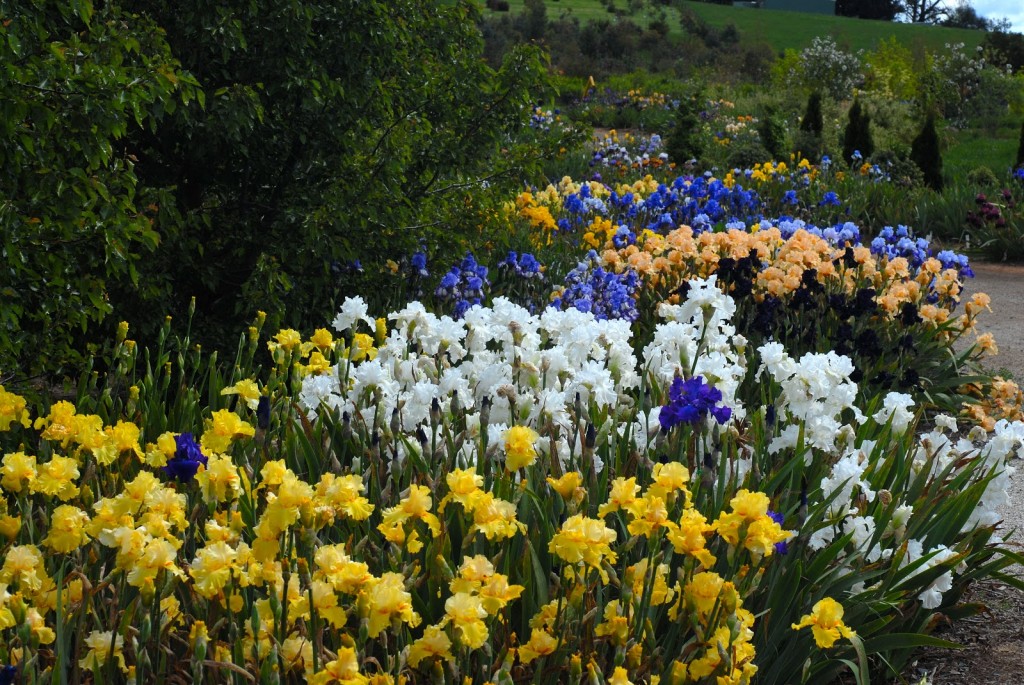
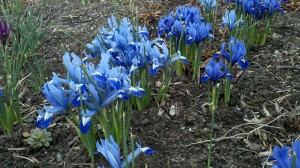
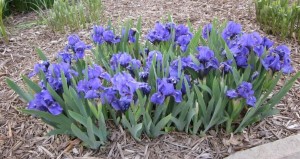
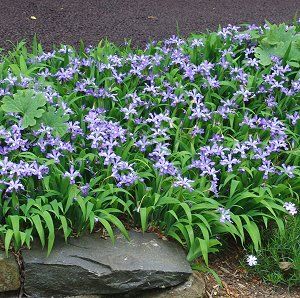
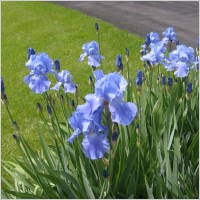
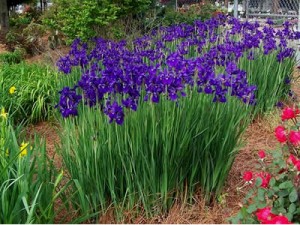
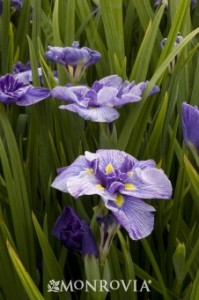
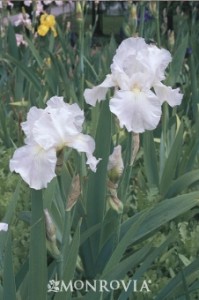
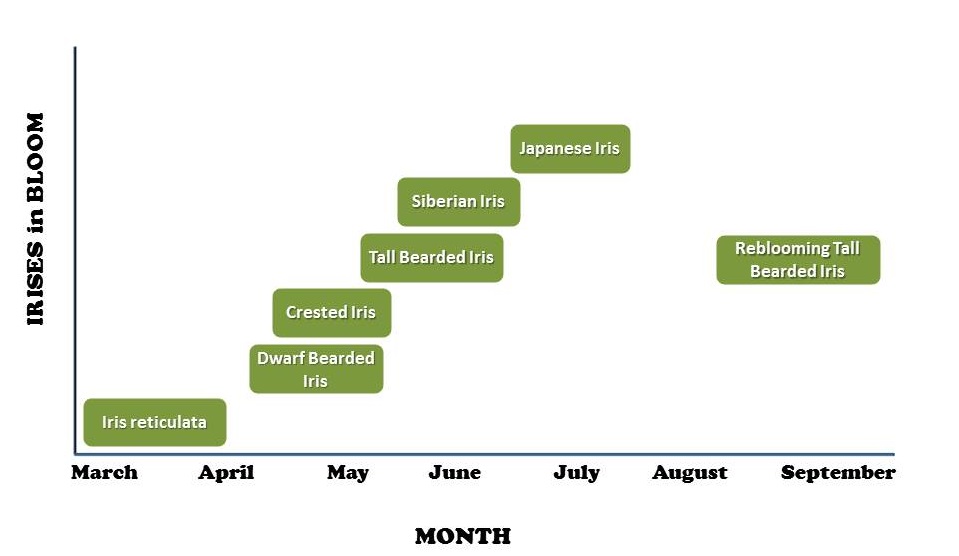
Hello and thank you for this article. I also love the graph! My very first iris were planted last fall and they came up beautifully last month. I was so sad to see them gone so quickly though! Reading this article seems like someone wrote it just for me. I’m sure iris lovers must feel the same way though! I just wanted to thank you and I will be looking at the different types locally and online.